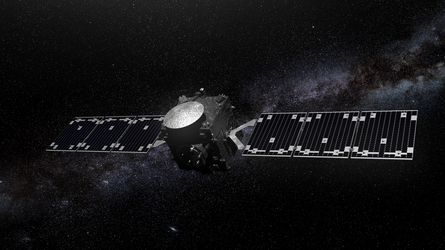

Hera asteroid mission, shaken not stirred
How could the Hera mission team become certain their asteroid-explorer spacecraft was robust enough to be flown into space aboard a rocket? They took their spacecraft and shook it bodily, replicating the kind of vibrations it will experience on the day of launch.
The spacecraft is seen here on the Test Centre’s 640kN QUAD shaker, whose metal plate is moved vertically by a quartet of water-cooled electrodynamic shakers. The forward-facing side of Hera hosts the mission’s 1.13-m-diameter main antenna. Also seen are four of the red-tag-covered thrusters found on all corners of the spacecraft, which will manoeuvre Hera through space.
These tags were removed before the shaker was run, along with its solar wing protective covers, see this clip here.
“Our testing began with a low-level run to characterise the spacecraft, checking where the resonances are,” explains Paolo Martino, Hera systems engineer. “We already knew what to expect from a detailed ‘Finite Element Model’ of Hera’s structural behaviour, predicting what stresses will occur on various parts of the spacecraft.
“Next we did a full ‘sine run’, gradually building up in frequency and amplitude to the full-scale force of launch. Finally we performed another low-level sweep, to make sure that the spacecraft’s behaviour remained the same following this violent shaking. In the event, the shaker testing went smoothly. Together with Hera’s acoustic testing, this success gives us confidence in the mission’s ability to endure next year’s rocket lift-off and flight into space.”
Hera is Europe’s contribution to an international planetary defence experiment. Following the DART mission’s impact with the Dimorphos asteroid last year – modifying its orbit and sending a plume of debris thousands of kilometres out into space – Hera will return to Dimorphos to perform a close-up survey of the crater left by DART. The mission will also measure Dimorphos’ mass and make-up, along with that of the larger Didymos asteroid that Dimorphos orbits around.
Hera is scheduled for launch in October 2024, to rendezvous with the Didymos and Dimorphos asteroid system about two years later.
At approximately 3000 sq. m in area, ESA’s ESTEC Test Centre in Noordwijk, the Netherlands, is the largest satellite testing establishment in Europe, equipped with facilities to simulate every aspect of launch conditions and the orbital environment.
Hera is now undergoing various functional tests and preparation for its next important testing milestone – sustained operation in space-grade vacuum and temperature extremes within a thermal vacuum chamber, scheduled for early next year. These will be followed by testing of the inter-satellite links to keep Hera connected to the pair of CubeSats it will deploy around Dimorphos.
The Hera spacecraft was developed and built for ESA by OHB System AG.





